2015 F800gs Review
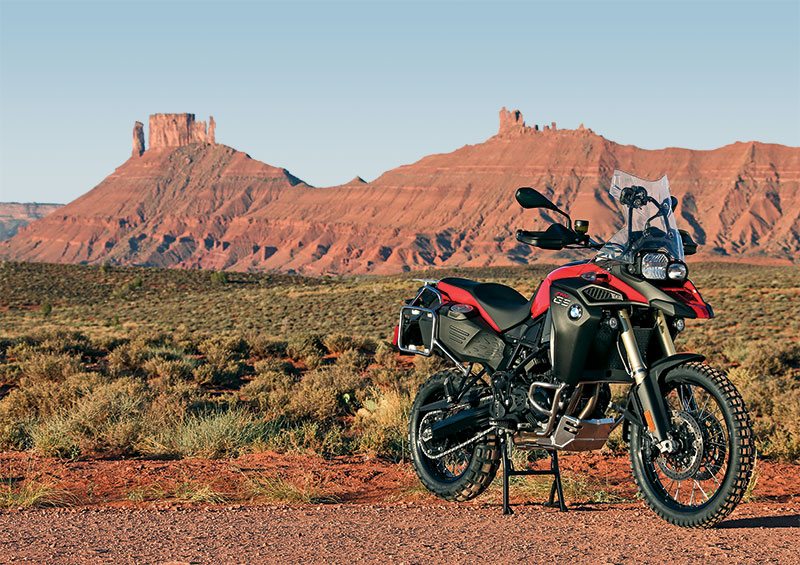
When the BMW F 800 GS was introduced for 2009, it offered the touring enduro versatility of the popular R 1200 GS but in a lighter, less expensive package, powered by a revised version of the liquid-cooled 798cc parallel-twin from the F 800 S, with a larger radiator, wet clutch, chain final drive and more torque. On Jett Tuning's dyno, our 2009 test bike made 76.8 horsepower and 53.5 lb-ft of torque at the rear wheel. With spoked wheels, a 21-inch front hoop and extra-long suspension travel, its off-road intent was clear, and the addition of hand guards, a skid plate and knobby tires quickly transformed it into a backcountry bomber. We liked the F 800 GS so much, we crowned it Motorcycle of the Year for 2009.
Minor updates for 2013 included new switchgear, instrumentation, side trim, turn signals and taillight covers, plus new options like a low suspension kit, Anti Spin Control (ASC) and Electronic Suspension Adjustment (ESA), which allows the rider to adjust rebound damping of the rear shock at the press of a button. Unlike most other ESA-equipped BMWs, however, the front suspension settings are non-adjustable, and rear spring preload is set by hand using a remote adjuster knob.
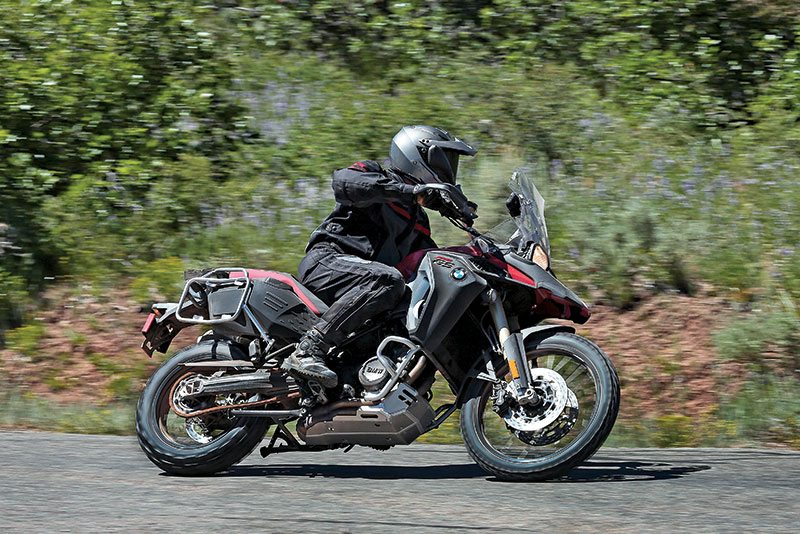
For 2014, the F 800 GS has realized its full go-anywhere, do-anything potential in the form of an all-new Adventure model. BMW has offered up-spec Adventure versions of its R 1150/1200 GS since 2002, but this is the first middleweight GSA. Compared to the standard R 1200 GS, the Adventure has a larger fuel tank, taller suspension (and seat height), a lower first gear, cross-spoke wheels, engine and hand guards, a skid plate and a centerstand—and that's before plunging down the rabbit hole of options. (An Adventure version of the new liquid-cooled R 1200 GS hasn't yet been released, but we expect to see one soon.)
Advertisement
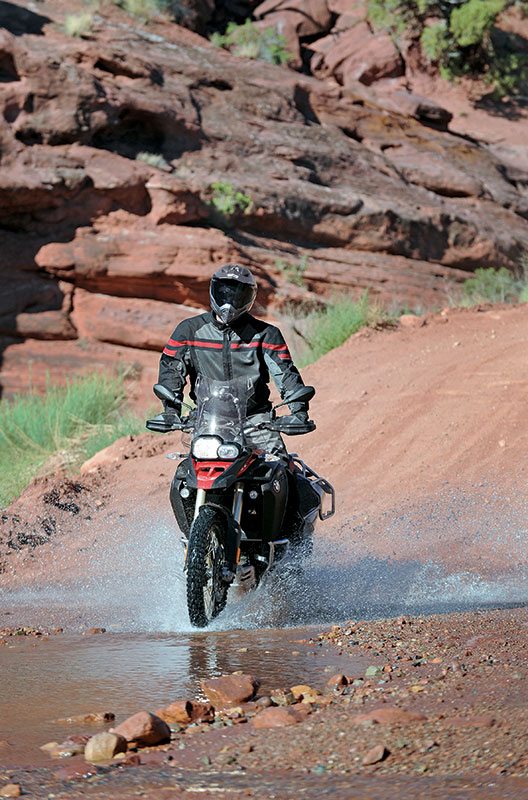
The F 800 GS Adventure takes after its big brother, making extended touring range a top priority. Its underseat fuel tank holds 6.3 gallons, up 2.1 gallons from the standard model, with a stronger subframe and protection bars that double as mounts for the accessory side cases. A new two-tone comfort seat is 0.4-inch taller than stock, raising seat height to a lofty 35 inches (an optional low seat is 33.9 inches). Since the base model has 9.1/8.5 inches of suspension travel, a taller fork and shock were deemed unnecessary. Wind protection has been improved with wider side panels and a taller windscreen that's vented at the top to reduce buffeting. Both the front fender and rear brake pedal have been reinforced, and the latter has a height-adjustable footrest for stand-up riding. Wide enduro footpegs with removable rubber inserts, an aluminum luggage rack, hand guards, engine protection bars, a modest skid plate and an accessory socket are all standard.
Of course, no BMW seems complete without some options. Our F 800 GSA test bike is what BMW calls "Fully Loaded," adding three packages: Enduro (ASC, plus Enduro mode for ASC/ABS), Comfort (heated grips, onboard computer, centerstand) and Active (ESA, LED fog lights). MSRP for the standard model is $13,550, and the "Fully Loaded" version is $14,995, so the extra $1,445 is money well spent. Our test bike is also fitted with no-cost optional Continental TKC80 knobby tires (more street-biased Metzeler Tourances are also available), a heavy-duty aluminum skid plate ($330) and a BMW Navigator Adventure GPS ($799)—all of which are smart upgrades for off-road riding—bringing the total to $16,124.
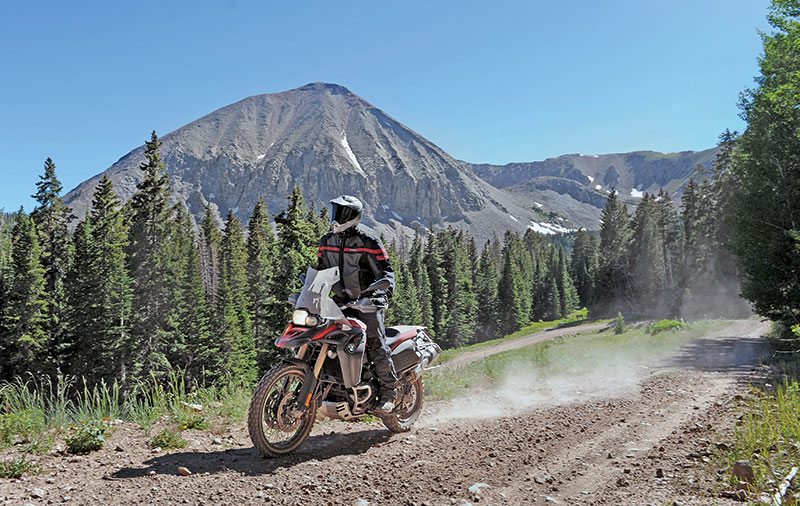
BMW hosted a press launch for the F 800 GS Adventure in Moab, Utah, leading us on a 175-mile test ride that was mostly off-road. After just 3 miles on pavement, we turned onto Onion Creek Road, a dirt road that winds its way through red rock and splashes through the eponymous creek two dozen times in the first 10 miles. Standing up on the wide, cleated pegs, the GSA felt nimble and comfortable, lighter than its 530-pound wet weight. Either seated or standing, the wide handlebar is at a comfortable height and the midsection of the bike is slender between the knees. It's easy to stay balanced on the pegs while keeping a light grip on the handlebar, perfect for shifting weight rearward to blast through water crossings and sandy washes. Crisp throttle response, a light clutch pull, an easy shifting transmission and precise brakes make short work of steep, rocky descents and messy, mountain-goat hairpins. The TKC80 knobbies, designed for 60/40 off/on-road riding, bite well in the dirt and don't squirm much on the road.
For most of the off-road portion of our test ride, I motored along in Enduro mode, which doesn't affect engine performance but delays ASC and ABS intervention. Both can be turned off, but I left them on because they worked so well, allowing moderate power slides and confident stops on dicey terrain, though an optional Enduro Pro mode that turns off rear ABS, like on the new R 1200 GS, would be a plus. For pavement riding, I switched over to Road mode, which steps up the sensitivity of both ASC and ABS to normal levels. With rear preload cranked up for my weight, the tall suspension soaked up big hits without bottoming and exhibited good damping over a wide range of surfaces, though the non-adjustable fork dives easily under heavy braking. Toggling the ESA button, I set rear damping to Comfort for technical off-road riding, Sport for canyon carving and Normal for everything else.
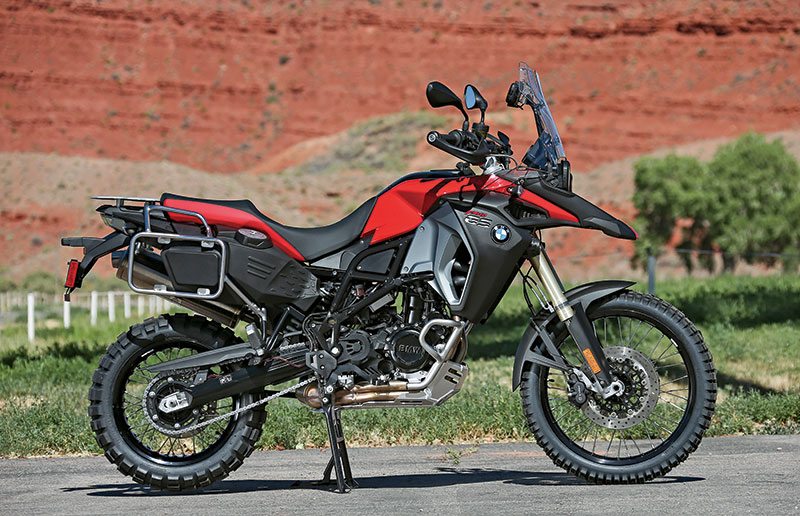
Following the official press ride, with a set of aluminum side cases mounted ($1,070), I embarked on a two-day, 1,200-mile ride home to California on paved back roads. Whether on long, straight highways or tight, twisted byways, the F 800 GSA was stable, agile and responsive. Though the knobbies are getting a bit worn, it has soldiered on since as a daily commuter and a two-up day-tripper. The tall windscreen slices through the air cleanly but somewhat noisily, and the added wind protection of the hand guards and wider side panels are a relief during long days in the saddle. At 35 inches, the GSA's new seat is tall but the thicker, sculpted padding is far superior to the plank on the standard model. On the down side, the engine puts out a lot of heat, roasting my shins at times, even on mild days. When the mercury topped 112 degrees in the Mojave Desert, I put my heels up on the engine guards for relief. As we've noted in other tests, the F 800 parallel twin is buzzy at higher revs. Also, the fuel gauge doesn't show any detail above half-full, so unless you reset the tripmeter at each fill-up you may not know how much fuel is available when facing a particularly long stretch between gas stations. During a recent fill-up I added 4.2 gallons (two-thirds of a tank), but the gauge had yet to fall below half-full.
Even if you never plan to take the F 800 GS Adventure off-road, the many upgrades on this version make it a much better touring motorcycle, starting at just $1,200 more than the standard model. From the extended range to the improved wind protection to the added comfort and tip-over protection, however you define adventure, the F 800 GSA will take you there.
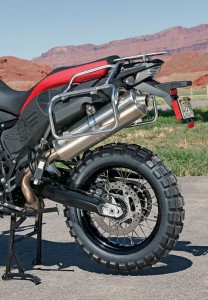
2014 BMW F 800 GS Adventure Specs
Base Price: $13,550
Price as Tested: $16,124 ("Fully Loaded" Package, aluminum skid plate, BMW Navigator Adventure)
Warranty: 3 yrs., 36,000 miles
Website: bmwmotorcycles.com
Engine
Type: Liquid-cooled, transverse parallel twin
Displacement: 798cc
Bore x Stroke: 82.0 x 75.6mm
Compression Ratio: 12.0:1
Valve Train: DOHC, 4 valves per cyl.
Valve Insp. Interval: Varies, computer monitored
Fuel Delivery: EFI (Digital Engine Mgmt. BMS-K+), 46mm throttle bodies x 2
Lubrication System: Dry sump, 3.2-qt. cap.
Transmission: 6-speed, cable-actuated wet clutch
Final Drive: O-ring chain
Electrical
Ignition: Digital BMS-K+
Charging Output: 400 watts max.
Battery: 12V 14AH
Chassis
Frame: Tubular-steel trellis w/ engine as stressed member & cast aluminum swingarm
Wheelbase: 62.1 in.
Rake/Trail: 26 degrees/4.6 in.
Seat Height: 35.0 in. (optional low seat: 33.9 in.)
Suspension, Front: 43mm male-slider, no adj., 9.1-in. travel
Rear: Single shock w/ 8.5-in. travel, remotely adj. for spring preload w/ electronically adj. rebound damping (ESA, as tested)
Brakes, Front: Dual 300mm floating discs w/ 2-piston pin-slider caliper & ABS
Rear: Single 265mm disc w/ 1-piston pin-slider caliper & ABS
Wheels, Front: Spoked aluminum, 2.15 x 21 in.
Rear: Spoked aluminum, 4.25 x 17 in.
Tires, Front: 90/90-T21
Rear: 150/70-QB17
Wet Weight: 531 lbs. (as tested)
Load Capacity: 469 lbs. (as tested)
GVWR: 1,000 lbs. (as tested)
Performance
Fuel Capacity: 6.3 gals., last 1.0 gal. warning light on
MPG: 89 PON min. (high/avg/low) 45.6/43.0/41.2
Estimated Range: 271 miles
Indicated RPM at 60 MPH: 3,400
Advertisement
Source: https://ridermagazine.com/2013/10/03/2014-bmw-f-800-gs-adventure-road-test/







Tidak ada komentar:
Posting Komentar